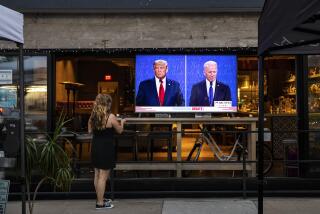Moody’s predicts soft TV ad spending, but 2016 to set records
- Share via
Broadcast TV outlets have been bracing for a difficult year in advertising, with ad revenues expected to fall by 6% to 9% compared to last year, according to a forecast by Moody’s Investor Service.
Growth in national advertising has stalled as marketers shift their dollars to digital outlets and cable TV channels. Local advertising, the key driver for television stations, should offset the weakness in national advertising, according to Moody’s report released early Wednesday.
However, the two-year outlook is particularly sunny.
Next year should be a blockbuster year with political ad spending expected to reach record levels. Candidates for the U.S. presidency, Congress and state offices will spend large sums throughout the primary season and for the general election.
“Political advertising revenue defies gravity,” Carl Salas, senior credit officer for Moody’s, told The Times.
Television advertising, particularly at the local level, has long been cyclical. This year likely will be soft because of a lack of political campaigns. In addition, 2015 is an off-year for the Olympics, which attract hundreds of millions of TV ad dollars every two years.
Political action committees have turbo-charged campaign spending levels.
“Next year will be the first time there is no incumbent since the Supreme Court’s 2010 ruling that eliminated campaign spending caps,” Salas said.
“Everything will be up for grabs,” he said. “And PACs already have signaled their plans to spend heavily.”
The surge is campaign spending to local TV stations explains the recent consolidation of TV station ownership groups. Several media companies, including Gannett, Tribune Media and Sinclair in the last two years have snapped up TV stations, in large part, to reap the bounty of political dollars.
While Moody’s has not yet formulated an estimate, political spending in 2016 should top $3.5 billion, Salas said.
That represents a 20% increase in the $2.9 billion spent in 2014 for the congressional and state contests.
“A lot of money is being raised and earmarked for campaigns,” Salas said. “And two-thirds of that money goes for television.”
Moody’s report said that advertising spending should not falter as long as the U.S. economy avoids a recession and unemployment levels remain below 7%.
Core advertising sources — which include Hollywood movie studios, retailers, restaurants, beverage companies and automakers — have been fairly stable.
“Core advertising remains the vast majority of spending,” Salas said.
Twitter: @MegJamesLAT
More to Read
From the Oscars to the Emmys.
Get the Envelope newsletter for exclusive awards season coverage, behind-the-scenes stories from the Envelope podcast and columnist Glenn Whipp’s must-read analysis.
You may occasionally receive promotional content from the Los Angeles Times.







